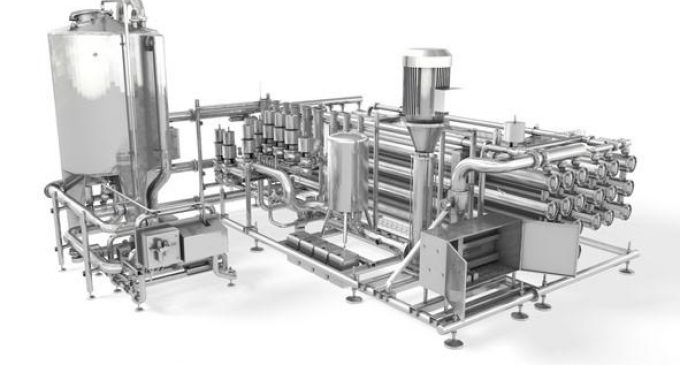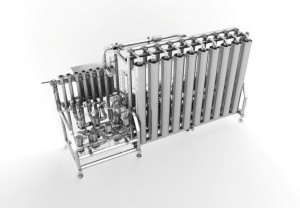Ozone-free Filling For Water – Bromate in Drinking and Mineral Water

Ozone is one of the strongest disinfectants employed in the beverage industry. Its use when bottling water has many advantages, since this molecule provides disinfection for simply everything: water, filler, bottles, closures, and the bottle’s head space as well. But, under certain preconditions, bromates may be produced during disinfection with ozone, and these constitute a possible health risk. The larger beverage producers, in particular, are therefore reducing the internally permissible values for the bromate content in the water for their own products, or want to eliminate the use of ozone entirely. In order to make this possible, Krones has developed a holistic machinery concept for microbiologically safe filling of mineral and table water without featuring ozonisation.
Strategies For Avoiding Bromate Formation
The possible strategies for avoiding bromate formation include:
- Do not use sodium hypochlorite as disinfectant
- Fully demineralise the water prior to ozonisation, and subsequently remineralise it (table water)
- Set the pH-value appropriately prior to ozonisation (e.g. by means of CO2)
- Optimise the dwell time (CxT)
- Use membrane filtration instead of ozone (ultra-filtration).
Ozone-free Filling Concept For Mineral and Table Water
If, for the above-mentioned reasons, a client wishes to discontinue ozonising his water, an ultra-filtration routine can replace treating the water with ozone. For filling table water, it would also be possible to use reverse osmosis in a Hydronomic RO unit, and where appropriate subsequent mineralisation in a Hydronomic MDS (Mineral Dosing Station). After that, ozonisation may continue to be run in the standard mode. Depending on the national legislation applying in each case, it would also be conceivable to use a UHT process in the Krones AquaAsept sterile water UHT unit.
 For mineral water, by contrast, it is prohibited, almost everywhere, to use reverse osmosis as a treatment option, because of the national legislation applying to natural mineral water. On the other hand, the use of ultra-filtration in mineral-water treatment is permitted in some countries. For this purpose, Krones offers a holistic concept in which all the machines of a line are harmonised with each other for optimum hygiene. The aim here is to ensure that the water after treatment exhibits less than one colony-forming unit per millilitre. The Hydronomic UF ultra-filtration unit, which removes particles up to a size of 0.02 micrometres from the mains water, statistically achieves a germ figure of one germ per ten 1-litre bottles, corresponding to a reduction of log 6.
For mineral water, by contrast, it is prohibited, almost everywhere, to use reverse osmosis as a treatment option, because of the national legislation applying to natural mineral water. On the other hand, the use of ultra-filtration in mineral-water treatment is permitted in some countries. For this purpose, Krones offers a holistic concept in which all the machines of a line are harmonised with each other for optimum hygiene. The aim here is to ensure that the water after treatment exhibits less than one colony-forming unit per millilitre. The Hydronomic UF ultra-filtration unit, which removes particles up to a size of 0.02 micrometres from the mains water, statistically achieves a germ figure of one germ per ten 1-litre bottles, corresponding to a reduction of log 6.
The water treated in the ultra-filtration system is then passed to the filler, which is supplied with PET containers by a blow-moulder. In its simplest configuration, the concept here features a Contiform 3 blow-moulder, with a preform feed system in hygienic design and a preform rinser. If the bottler wishes a higher standard of hygiene, then one of the following options can be used:
- a Contiform 3 with Contipure preform decontamination
- a Contiform 3 with an UltraClean preform rinser
- a Contiform 3 with PreBeam preform sterilisation by means of electron beams
- or a Contiform AseptBloc, an aseptic blow-moulder/filler block.
In the simplest case, however, a Contiform 3 blow-moulder with a preform feed system in hygienic design and a preform rinser is sufficient. In this case, there is no need for a bottle rinser upstream of the filler.
The filler itself is a Modulfill model in hygienic design, but enclosed inside a cleanroom, and fitted with a foam-cleaning feature, UV closure treatment and neck steriliser, so as to avoid recontamination. Here, too, there are various other options if the client wishes a higher standard of hygiene, for instance:
- a Modulfill with an UltraClean two-channel rinser
- a Modulfill Asept modularised aseptic filler a PET-Asept L2 aseptic block.

































